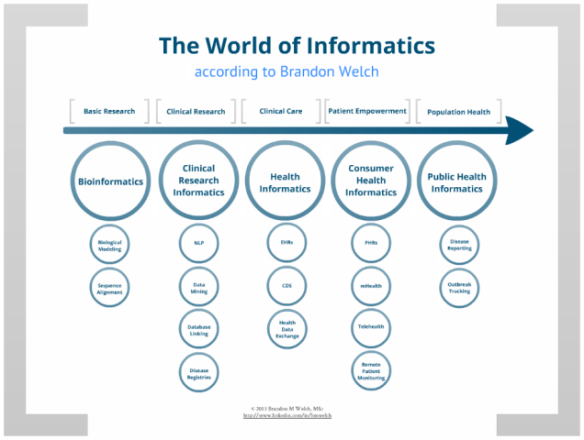As part of my PhD work, I’m conducting an IRB-approved anonymous survey entitled “Validating a proposed technical desiderata for the integration of genomic information with clinical decision support among domain experts”. We developed a set of requirements that must be met for a clinical decision support (CDS) architecture to support whole genome sequence information at the point of care. Our goal with this survey is to validate these proposed requirements among CDS and genome experts. If you are a domain expert in either of these fields, I invite you to take this survey located at:
https://redcap01.brisc.utah.edu/ccts/redcap/surveys/?s=7Rp3As
The text below is the background text included in the survey.
BACKGROUND
The application of whole genome sequencing (WGS) in routine clinical care is quickly approaching. Having a patient’s genomic information could allow clinician’s to identify health risks, improve diagnosis, and tailor treatment, all under the paradigm of personalized medicine. However, were the WGS to be widely available in the clinic today, many of these capabilities could remain unachieved for a number of reasons, including the complexity of genetic analysis, practicing clinicians’ limited proficiency in genetics, and the insufficient number of genetics professionals in the workforce (1).
Nevertheless, computerized clinical decision support (CDS) within the electronic health record (EHR) offers a reasonable solution to overcome these barriers and help clinicians leverage a patient’s WGS information at the point of care (2). CDS entails providing clinicians, patients, and other healthcare stakeholders with pertinent knowledge and person-specific information, intelligently filtered or presented at appropriate times, to enhance health and healthcare (3). Examples of point-of-care CDS include medication dosing support, order facilitators, alerts and reminders, relevant information display, expert systems, and workflow support (4).
Masys et al. developed a set of requirements to incorporate genomic variation into the EHR for the provision of healthcare services (5). The requirements include the following:
1. Maintain separation of primary molecular observations from the clinical interpretations of those data
2. Support lossless data compression from primary molecular observations to clinically manageable subsets
3. Maintain linkage of molecular observations to the laboratory methods used to generate them
4. Support compact representation of clinically actionable subsets for optimal performance
5. Simultaneously support human-viewable formats and machine-readable formats in order to facilitate implementation of decision support rules
6. Anticipate fundamental changes in the understanding of human molecular variation
7. Support both individual clinical care and discovery science
This set of requirements provides a strong set of guiding principles to integrate genomic information into the EHR. However, in our effort in developing CDS capabilities for WGS data, we have identified ADDITIONAL REQUIREMENTS specific to CDS to augment the original Masys desiderata. These additional requirements are as follows (further described in the survey):
8. Keep CDS knowledge separate from variant classification
9. Support a large number of gene variants while keeping CDS logic as simple as possible
10. CDS knowledge must be able to incorporate multiple genes and clinical information
11. Access and transmit only the genomic information necessary for CDS
12. Leverage current and developing CDS and genomics infrastructure and standards
13. Support a CDS knowledge base deployed at and developed by multiple independent organizations
14. Have the capacity to support multiple EHR platforms with various data representations with minimal modification
OBJECTIVE
The intent of this survey is to VALIDATE THIS ADDITIONAL SET OF REQUIREMENTS AMONG DOMAIN EXPERTS in CDS and/or genomics. On subsequent pages of this survey, each of these requirements are described in further detail with a Likert scale question to assess the importance of that particular requirement. If desired, there is an optional comment field after each requirement to provide suggestions for improvement and/or reasoning for your response on the importance of the requirement. Finally, general comments can be provided regarding any overarching recommendations or ideas for additional requirements. Survey responses will be reviewed and incorporated into the requirements by the following panel of experts:
Brandon M Welch, MS
Karen Eilbeck, MS, PhD
Laurence J. Meyer, MD, PhD
Guilherme Del Fiol, MD, PhD
Kensaku Kawamoto, MD, PhD
We request that you keep the content confidential until survey results have been published. Thank you for your participation.
DEFINITIONS OF SELECT TERMS USED IN THE SURVEY
Molecular observations: The patient-specific information obtained from sequencing technologies which include the identification and location of variants in DNA, RNA, and protein sequence. Example representation in Human Genome Variation Society (HGVS) format: MSH2 c.1452_1455delAATG
Variant interpretations: Disease causing genes can have one of many known variants present. However, not all variants are pathogenic. Some variants are benign, and others have unknown pathogenicity (also known as variants of unknown significance [VUS]). The American College of Medical Genetics and other groups have put forth various recommendations for variant classification, including pathogenic, likely pathogenic, likely benign, benign, or variant of unknown significance (18). An example variant classification for the MSH2 variant in the above example is Pathogenic.
CDS knowledge: CDS (described above) provides guidance to clinician on how to care for a patient when a particular variant is present or absent. Continuing the previous example of a patient with a pathogenic mutation in the MSH2 gene, a CDS alert for this person could say the following: “This patient is at increased risk for colorectal cancer (Lynch syndrome I). The patient should be placed on an NSAID and receive a colonoscopy annually. This patient should be referred for genetic counseling and to an oncology specialist.”
REFERENCES
1- http://www.ncbi.nlm.nih.gov/pubmed/22918138
2- http://www.ncbi.nlm.nih.gov/pubmed/22922173
3- http://www.ncbi.nlm.nih.gov/pubmed/17213487
4- http://www.ncbi.nlm.nih.gov/pubmed/21415065
5- http://www.ncbi.nlm.nih.gov/pubmed/22223081






